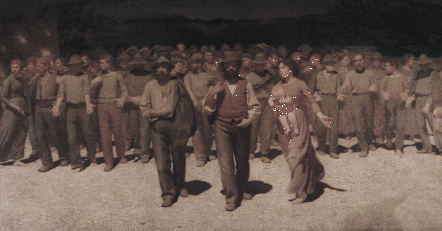
ANARCHIST COMMUNISTS: A QUESTION OF CLASS
3.3.
Class Struggle (antagonism)
As we have said, the materialist conception of history implies the conception that society is divided into classes and that the interests of these classes are fatally opposed and irreconcilable. This too is an idea which is shared by the whole class-struggle left and is not an invention of Marxism (as certain non-class struggle Anarchists think). It is a reality known even before the theoretical works of Marx and Engels, though this pair did provide a coherent, convincing description of it. As in the case of historical materialism, though, also in this case the paths of Marxism (or better still, the different varieties of Marxism) and Anarchist Communism quickly diverged on three fundamental points: the causes of the class struggle, the development of the class struggle, and the relationship between the condition of the proletariat class and the consciousness that it develops of this condition.
For Anarchist Communism, the class struggle is developed within the full flowering of capitalist society primarily as a result of the material conditions that the proletariat has to live in. But as these conditions are not new, nor are they as bad as in past days, other joint causes are needed: a fundamental role is surely played by the fact that the capitalist organization of labour concentrates large masses of workers into the same physical space, both for production and in daily life, easing the way for political aggregations. Our agreement with the Marxists is thus far complete. Marxists, however, tend to overvalue this important aspect, to the point of considering it the only possible aspect and consider it completely as an internal movement of the productive forces, who in their development create the conditions for the birth of workers' antagonism and therefore threaten from within, for that same reason, the very life of capitalist class society. They therefore limit the class struggle to the version of factory struggles, particularly in industry, which best represents the advanced stage of technical and productive development. Anarchist Communists, on the other hand, though recognizing the decisive importance of the two factors mentioned before, believe that others have their role to play: the growth in education (not so much regarding schooling, but in the circulation of ideas), which is dragged along by labour once liberated from feudalism; an idea of social justice which emerges from the mists of impatience which have always been produced in every society which is marked by deep inequality; finally, utopia - the embodiment of a less unfair world. The Marxists would say these are superstructural factors (or idealistic, or worse still, petit-bourgeois), but nonetheless of great importance and, most importantly, they do not relegate the class struggle to that between workers and individual bosses, but include the whole struggle between the exploited and their exploiters, embracing also the demands of the peasants.
This is the source of the second point of dissent. For Marxists, wherever capitalism develops is where the moment of Communist revolution draws near, whereas the old-fashioned production methods (crafts, peasant agriculture, etc.) are inexorably eliminated, thereby facilitating progress. However, revolutions have always occurred in places where capitalism was not yet fully developed and while the new working class (still in a minority) may have provided grist for the political vanguard's mill, nothing could have happened without the involvement of the endless masses of peasants.

The third point of divergence is the bitterest: the relationship between the condition of the class and the consciousness of its real interests, as interests opposed to those of the proprietary class. Once again for Marxists this is a problem which does not exist. Either because, for some of them, the two (class and class consciousness) are destined to merge, deterministically and spontaneously, coinciding, driven by the evolution of productive forces, overlapped by the development of the economic structure. For others, since it is not necessary for the entire proletarian mass (nor even the worker minority within it) to be class conscious, it is sufficient that there be a compact vanguard nucleus, in other words the party. In its Leninist version, the party is actually outside the workers' movement, as the workers are incapable of raising themselves to the revolutionary doctrine as they are weighed down by their own inevitable economism, that is to say their immediate, daily needs which are different to and irreconcilable with their historical needs - something they are incapable of understanding. For Anarchist Communists, on the other hand, the relationship between the class and its consciousness can be affected by the more advanced, politicized elements who act within the proletariat (being a part of it) in order to stimulate consciousness of its historical interests through the day-to-day struggles which seek to provide answers to the needs of the immediate present. This is because the greater the unity and consciousness in the proletariat, the better the chances of a revolution being able to assume an Anarchist Communist character quickly, enabling the class to build the new society without delegating the task to anyone.